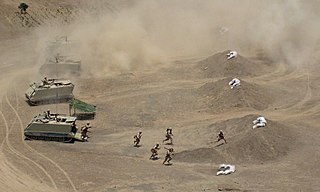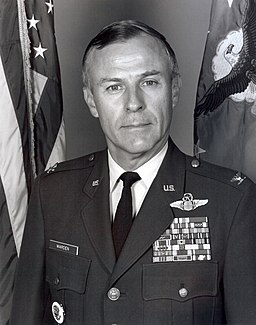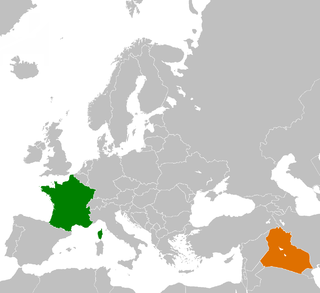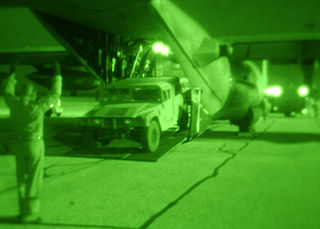
World War III and the Third World War are names given to a hypothetical third worldwide large-scale military conflict subsequent to World War I and World War II. The term has been in use since at least as early as 1941. Some have applied it loosely to refer to limited or smaller conflicts such as the Cold War or the War on Terror, while others assumed that such a conflict would surpass prior world wars both in its scope and its destructive impact.

The Gulf War, codenamed Operation Desert Shield for operations leading to the buildup of troops and defense of Saudi Arabia and Operation Desert Storm in its combat phase, was a war waged by coalition forces from 35 nations led by the United States against Iraq in response to Iraq's invasion and annexation of Kuwait arising from oil pricing and production disputes. The war is also known under other names, such as the Persian Gulf War, First Gulf War, Gulf War I, Kuwait War, First Iraq War or Iraq War, before the term "Iraq War" became identified instead with the 2003 Iraq War.

The United States Central Command is a theater-level Unified Combatant Command of the U.S. Department of Defense. It was established in 1983, taking over the previous responsibilities of the Rapid Deployment Joint Task Force (RDJTF).
Operation Bramble Bush was an Israeli plan to assassinate the then president of Iraq, Saddam Hussein, in 1992. It was described in full in December 2003 by the Israeli newspaper Yedioth Ahronoth, though news reports had circulated about the plot since January 1999. The plan was conceived as retaliation for Iraqi Scud missile attacks during the Gulf War.

Herbert Norman Schwarzkopf Jr. was a United States Army General. While serving as the commander of United States Central Command, he led all coalition forces in the Gulf War.

The Fist of God is a 1994 suspense novel by British writer Frederick Forsyth, about the Iraqi Project Babylon and the resulting "supergun".

A military exercise or war game is the employment of military resources in training for military operations, either exploring the effects of warfare or testing strategies without actual combat. This also serves the purpose of ensuring the combat readiness of garrisoned or deployable forces prior to deployment from a home base. War games involving two or more countries allows for better coordination between militaries, observation of enemy's tactics, and is a visible show of strength for the participating countries.
Able Archer 83 is the codename for a command post exercise carried out in November 1983 by the North Atlantic Treaty Organization (NATO). As with Able Archer exercises from previous years, the purpose of the exercise was to simulate a period of conflict escalation, culminating in the US military attaining simulated DEFCON 1 coordinated nuclear attack. Coordinated from the Supreme Headquarters Allied Powers Europe (SHAPE) headquarters in Casteau, Belgium, it involved NATO forces throughout Western Europe, beginning on November 7, 1983, and lasting for five days.

Operation Desert Thunder was a response to threats by Iraq's president Saddam Hussein to shoot down U-2 spy planes, and violate the no-fly zone set up over his country. The operation was designed to bring stability to the region by bringing in a military presence during the negotiations between Iraq and the UN over weapons of mass destruction. The name Operation Desert Thunder has been applied to the build-up of forces in the Persian Gulf region during 1998.
Operation Opera, also known as Operation Babylon, was a surprise Israeli air strike carried out on 7 June 1981, which destroyed an Iraqi nuclear reactor under construction 17 kilometers southeast of Baghdad. The operation came after Iran's unsuccessful Operation Scorch Sword operation had caused minor damage to the same nuclear facility the previous year, the damage having been subsequently repaired by French technicians. Operation Opera, and related Israeli government statements following it, established the Begin Doctrine, which explicitly stated the strike was not an anomaly, but instead “a precedent for every future government in Israel.” Israel's counter-proliferation preventive strike added another dimension to their existing policy of deliberate ambiguity, as it related to the nuclear capability of other states in the region.

The Iraqi Armed Forces are the military forces of the Government of Iraq. They consist of the Iraqi Army, the Iraqi Air Force, and the Iraqi Navy.
American support for Ba'athist Iraq during the Iran–Iraq War, in which it fought against post-revolutionary Iran, included several billion dollars' worth of economic aid, the sale of dual-use technology, non-U.S. origin weaponry, military intelligence, and special operations training. However, the U.S. did not directly supply arms to Iraq. Of particular interest for contemporary Iran–United States relations are the repeated accusations that the U.S. government actively encouraged Iraqi leader Saddam Hussein to invade Iran, supported by a considerable amount of circumstantial evidence, but the U.S. government officially denies that any such collusion occurred, and no conclusive proof of it has been found.

The 1991 uprisings in Iraq were a series of popular rebellions in northern and southern Iraq in March and April 1991 in a ceasefire of the Persian Gulf War. The mostly uncoordinated insurgency, often referred to as the Sha'aban Intifada among Arabs and as the National Uprising among Kurds, was fueled by the perception that then Iraqi President Saddam Hussein was responsible for systemic social repression and had become vulnerable to regime change. This perception of weakness was largely the result of the outcome of two prior wars: the Iran–Iraq War and the invasion of Kuwait, both of which occurred within a single decade and devastated the economy and population of Iraq.
According to most U.S. news networks, a majority of Americans support United States or Israeli military action against Iran. Other, more recent, polls point out that Americans "back a newly brokered nuclear deal with Iran by a 2-to-1 margin and are very wary of the United States resorting to military action against Tehran even if the historic diplomatic effort falls". Organised opposition to a possible future military attack against Iran by the United States (US) and/or Israel is known to have started during 2005–2006. Beginning in early 2005, journalists, activists and academics such as Seymour Hersh, Scott Ritter, Joseph Cirincione and Jorge E. Hirsch began publishing claims that United States' concerns over the allege threat posed by the possibility that Iran may have a nuclear weapons program might lead the US government to take military action against that country. These reports, and the concurrent escalation of tensions between Iran and some Western governments, prompted the formation of grassroots organisations, including Campaign Against Sanctions and Military Intervention in Iran in the US and the United Kingdom, to advocate against potential military strikes on Iran. Additionally, several individuals, grassroots organisations and international governmental organisations, including the Director-General of the International Atomic Energy Agency, Mohamed ElBaradei, a former United Nations weapons inspector in Iraq, Scott Ritter, Nobel Prize winners including Shirin Ebadi, Mairead Corrigan-Maguire and Betty Williams, Harold Pinter and Jody Williams, Campaign for Nuclear Disarmament, Code Pink, the Non-Aligned Movement of 118 states, and the Arab League, have publicly stated their opposition to such an attack.
It is a maxim of intelligence that intelligence agencies do not make policy, but advise policymakers. Nevertheless, with an increasingly fast pace of operations, intelligence analysts may suggest choices of actions, with some projection of consequences from each. Intelligence consumers and providers still struggle with the balance of what drives information flow. Dissemination is the part of the intelligence cycle that delivers products to consumers, and Intelligence Dissemination Management refers to the process that encompasses organizing the dissemination of the finished intelligence.

John Ashley Warden III is a retired colonel in the United States Air Force. Warden is a graduate of the United States Air Force Academy. His Air Force career spanned 30 years, from 1965 to 1995, and included tours in Vietnam, Germany, Spain, Italy, and Korea, as well as many assignments within the continental United States. Warden completed a number of assignments in the Pentagon, was a Special Assistant for Policy Studies and National Security Affairs to the Vice President of the United States, and was Commandant of the Air Command and Staff College.

French–Iraq relations refers to the relations between France and Iraq. France played a major role in Iraqi succession from the Ottoman Empire and eventual freedom from British colonial status. The Franco-Iraqi relationship is often defined by conflict and peace, supporting Iraq during the Iran-Iraq War, supporting intervention in Iraq in Operation Desert Storm, and opposing the 2003 Invasion of Iraq. As of 2004, Iraq maintains an embassy in Paris and France maintains an embassy in Baghdad.

Iraq–Pakistan relations refers to the foreign relations between the Republic of Iraq and the Islamic Republic of Pakistan. Cultural interaction and economic trade between Indus Valley and Mesopotamia date back to 1800 BCE. In 1955 Iraq and Pakistan joined the Baghdad Pact, a military alliance against the Soviet Union. However, when the king of Iraq was assassinated in 1958, Iraq pulled out of the Baghdad Pact, which was renamed as the Central Treaty Organization (CENTO). Tensions persisted between Iraq and Pakistan through the late twentieth and early twenty-first centuries with the Iran–Iraq War, the Gulf War, and the Iraq War. However the relations stabilized. Pakistan currently maintains an embassy in Baghdad and Iraq in Islamabad.

The United States Army Central, formerly the Third United States Army, commonly referred to as the Third Army and as ARCENT is a military formation of the United States Army, which saw service in World War I and World War II, in the 1991 Gulf War, and in the coalition occupation of Iraq. It is best known for its campaigns in World War II under the command of General George S. Patton.
"Desert Crossing" 1999 was a series of war games known simply as Desert Crossing that were conducted in late April 1999 by the United States Central Command (CENTCOM), in order to assess potential outcomes of an invasion of Iraq aimed at unseating Saddam Hussein. The games were led by Marine General Anthony Zinni (ret.) "When it looked like we were going in[to the 2003 invasion of Iraq], I called back down to CENTCOM and said, 'You need to dust off Desert Crossing.' They said, 'What's that? Never heard of it.'" . According to Air Force General Victor Renuart, the exercise's conclusions were considered but rejected because they called for an invasion force of three armored divisions, while CENTCOM planners favored a force of only one armored division bolstered by a light infantry division.





















